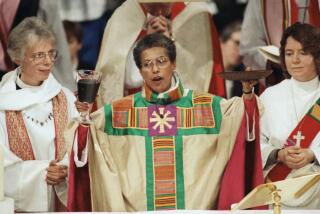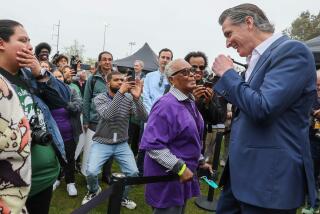Cracks Grow in Unity of Top-Ranking U.S. Catholics
For years ferment in the Roman Catholic Church has seethed within the ranks of the laity over a host of controversial issues, from the ordination of women to birth control.
Until now, American bishops--with the exception of several high profile liberals--have publicly remained above it all.
But cracks have begun to appear in the face of official unity so carefully constructed by the U.S. hierarchy. Prominent bishops and cardinals are publicly calling for sweeping reforms involving the power of the pope and bishops, and dialogue with dissenters over a host of issues that have polarized the church.
More surprising, their initiatives are drawing open rebuffs from other prominent bishops.
“It’s very unusual for cardinals to get into public fights,” said Father Thomas J. Reese, a veteran bishop watcher and senior fellow at Woodstock Theological Center at Georgetown University.
At the center of the storm are two of the church’s most senior and respected prelates.
First, retired Archbishop John R. Quinn of San Francisco called for the restoration of historic prerogatives of local bishops that he said have been usurped by Rome. Quinn also called for a rare convocation of the world’s 3,000 Catholic bishops to begin dealing with sensitive issues like birth control, priestly celibacy and how the church treats divorced and remarried Catholics.
Then, the nation’s senior active cardinal, Joseph Bernardin of Chicago, dying of cancer and troubled by “increasing polarization . . . and meanspiritness” within the church, said the time had come to nurture a new dialogue among Catholics of all viewpoints and seek common ground by openly discussing differences.
Both Quinn and Bernardin were careful to steer clear of any suggestion that they would tamper with fundamental church doctrine. Both couched their proposals with words of fealty to the Pope and to the teaching authority of the church.
But there was no mistaking their intent to embark upon a path that by its nature would be both public and at times painful.
Nor was there any mistaking the misgivings of other bishops.
Cardinal John J. O’Connor of New York, in a lengthy response in his archdiocesan newspaper to Quinn, defended the Vatican and argued that bishops are already consulted by Rome. Although the thrust of O’Connor’s reply was cordial and solicitous, he was clearly piqued by some issues raised by Quinn.
“Celibacy? Could it really be discussed much more than it has been? Should it be? Can it be without arousing false expectations?” O’Connor asked. “The ordination of women? Is it discussion of the subject that is needed, or a clear explanation of church teaching?” he wrote.
But by far the most biting criticism from bishops has been directed at Bernardin’s “common ground” initiative, announced last month but developed over several years.
Cardinal Bernard Law of Boston charged that a position paper, which has become the basis for Bernardin’s initiative, was “fundamentally flawed” and made “gratuitous assumptions.”
Cardinal James Hickey of Washington also panned the document, “Called to be Catholic: Church in a Time of Peril,” produced by the National Pastoral Life Center in New York. Hickey said the church unity sought by Bernardin cannot be achieved “by accommodating those who dissent from church teaching--whether on the left or on the right.”
Cardinal Roger M. Mahony, the archbishop of Los Angeles, who has endorsed the Bernardin initiative and is member of the common ground committee, said he was taken aback by the tone of the criticism.
“I was somewhat surprised at their statements and the strength of their statements,” Mahony said in an interview.
“There’s almost an assumption that . . . somehow this [common ground] group was going to be a change agent for the church. Of course, nothing could be further from the truth. I guess I was more puzzled than anything by their response,” Mahony told The Times.
The highly unusual public airing of differences has focused renewed attention on a litany of long-simmering issues, many of which have been straining the church for years, if not decades.
Surveys of American Catholics have long demonstrated a wide divergence between the official teachings of the church and the beliefs and practices of those in the pews.
Polls show, for instance, that a majority of Catholics in this country are open to the ordination of women and the use of contraception--both disallowed by the church.
Until recently, most dissent has been carried out by unofficial pressure groups made up of disaffected members of the laity, priests and nuns.
But, Reese, who has long tracked the comings and goings of the U.S. hierarchy, said the involvement of Bernardin and Quinn has raised the stakes and makes more pressing one central issue:
Is it possible for bishops to deal with dissent in the United States? Or will the church be torn by the deep divisions that have already rent the fabric of unity among Catholics in Europe?
European Catholics have gathered more than 2 million signatures urging the pope to undertake major reforms, including lifting the prohibition on the ordination of women. A similar petition drive is planned in the United States by a group called “We Are Church.”
Reese said those campaigns make Bernardin’s efforts even more important.
“Discussions and disputes are going on in the church anyway,” said Reese, author of soon-to-be-published “Inside the Vatican: The Politics and Organization of the Church.” “They’re not going to stop. Bernardin is trying to establish a process for courtesy, respect and Christian dialogue so that we don’t have a brawl in the church.’
That U.S. bishops would be quick to direct public criticism at the proposals by Bernardin and Quinn is an indication of how sensitive the issues are--and how daunting the challenge to forge a new dialogue out of the fires of division.
“Some of these [criticisms] have been sharp, indeed,” Bernardin said in a written response last week.
“To some extent, they confirm the need for this initiative. Even a carefully framed appeal for dialogue coming from an archbishop and seconded by a broad range of distinguished advisors was met with immediate suspicion,” Bernardin said.
Stung by their criticism, Bernardin felt compelled to reassure detractors that the dialogue he envisioned would be consistent with Catholic tradition and teaching. Earlier, Quinn, anticipating the challenges, had stressed that his call for a bishops’ conference did not necessarily mean he agreed with dissenters.
But bishops, as both defenders of the faith and pastors to their flock, must walk a fine line.
How is a dialogue possible on, say, the ordination of women when the Pope in 1995 issued a fiat ending discussion of the issue? How can the call for discussion not be perceived as a challenge to papal authority, not to mention the validity of church teachings?
Pope John Paul II has been unbending in his opposition to contraception and the ordination of women.
In that climate, “it is difficult to see how any genuine effort to reduce polarization could be fruitful,” said Francis Kissling, president of Catholics for a Free Choice, a liberal advocacy group not endorsed by the church.
Still, Bernardin, Mahony and others on the common ground committee are convinced the effort must be made.
At no time has there been a greater need for reflection, Mahony said. Religion, like society in general, has been “infiltrated” by declining civility and narrow interests, he said.
“We no longer have the broader church, but this little group--usually small in number--who declare themselves to be either ahead of the church, behind the church, with the church or wherever. But if you don’t meet their litmus test you are now the enemy. Now, that is not the Gospel of Jesus Christ.”
Others see another dynamic at work in the calls for dialogue. Bishops are looking ahead to the next pope and the shape of the church in Christianity’s third millennium.
“I think what we have is a sense on the part of the bishops that we’re in the twilight of this papacy and there’s an opportunity for change and realignment,” said Sister Maureen Fiedler of Catholics Speak Out, an independent reform organization favoring the admission of women to the priesthood.
The 76-year-old pope, who survived an assassination attempt in 1981 and also recovered from a broken hip, is known for his stamina. In the 18th year of his pontificate, he ardently hopes to usher in Christianity’s third millennium. Still, age is taking its toll.
“Those who see a need for reform see [this] as a time to do it,” said Tom Roberts, senior news editor of the National Catholic Reporter. “Sometime in the not too distant future there’s going to be another conclave” to elect a new pope.
As early as last year, 40 American bishops foreshadowed the latest controversy over dissent when they endorsed a 12-page document urging a greater voice in the church’s decisions and an ability to talk openly about “whatever affects church life.”
But there is a new urgency for Bernardin, as he confronts the church’s future and his own. The mild-mannered priest was recently told by doctors that he has less than a year to live because pancreatic cancer is spreading to his liver.
“When one comes face to face with the reality of death in a very profound way as a cancer patient, one’s perspective of life is altered dramatically,” he told reporters.
“What seemed so important before now is seen as trivial, and what is truly important invites new commitment and a realignment of priorities.”
More to Read
Sign up for Essential California
The most important California stories and recommendations in your inbox every morning.
You may occasionally receive promotional content from the Los Angeles Times.









